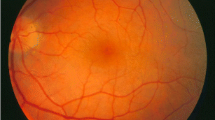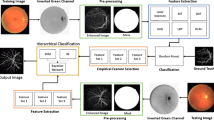Abstract
Changes in the retinal vasculature of the fundus image help in identifying retinal diseases. This is done by segmenting the retinal blood vessels. Computational approaches are preferred over traditional approaches for the segmentation of vessels as it is a time-consuming process. There are various techniques involved in the proposed Contrast Enhancement using Histogram Equalization algorithm such as image pre-processing and post-processing techniques, supervised and unsupervised learning techniques. Each stage is responsible for performing a series of actions. As the images are pre-processed, a feature vector is formed to which Principal Component Analysis is applied. The output is then subjected to k-means clustering to group the pixels obtained as vessel clusters or non-vessel clusters. The vessel clusters are not processed further, while the non-vessel clusters are subjected to ensemble classification which makes use of a decision tree along with bagging. The segmented image thus obtained is the combined result of clustering and ensemble classification technique. This segmented image thus obtained is then subjected to post-processing using morphological techniques. The images are then validated which shows that compared to the existing techniques, the proposed model for blood vessel segmentation shows 95% accuracy.










Similar content being viewed by others
Data availability
Enquiries about data availability should be directed to the authors.
References
Abràmoff MD, Garvin MK, Sonka M (2018) Retinal imaging and image analysis. IEEE Trans Med Imaging 1(3):169–208
Bhowmik KK, Roy S, Bhowmik AK “An optimal approach to detect retinal diseases by performing segmentation of retinal blood vessels using image processing,” In: Proceedings of the IEEE international conference on image processing, 2020, pp 59–63
Budai A, Bock R, Maler A et al (2018) Robust vessel segmentation in fundus image. Int J Biomed Imaging. https://doi.org/10.1155/2013/154860
Chakraborti T, Chowdry AS (2017) A self-adaptive matched filter for retinal blood vessel detection. Springer Verlag, Machine Vision and Applications. Berlin HeidelBerg
Chaudhuri S, Chatterjee S, Katz N et al (2018) Detection of blood vessels in retinal images using two-dimensional matched filters. IEEE Trans Med Imaging 8:263–269
Chen X, Wang L, Li K, Wu Y (2013) A review of image segmentation algorithms. Information Science 207:17–42
Cinsdikici MG, Aydin D (2017) Detection of blood vessels in ophthalmoscope images using MF/ant (matched filter/ant colony) algorithm. Comput Methods Programs Biomed 96:85–95
Dutta A, Bose P (2014) Retinal image segmentation: a survey. Pattern Recogn Lett 48:107–118
Frangi A, Niessen W, Vincken K, Viergever M (2018) Multiscale vessel enhancement filtering. Proc Med Image Comput 1496:130–137
Franklin SW, Rajan SE (2019) Computerized screening of diabetic retinopathy employing blood vessel segmentation in retinal images. Biocybern Biomed Eng 34:117–124
Fraz MM, Remagnino P, Hoppe A et al (2016) Blood vessel segmentation methodologies in retinal images – a survey. Comput Methods Programs Biomed 108(1):407–433
Hannink J, Dutta R, Bekkers E (2019) Crossing-preserving multiscale vesselness. Medical image computing and computer-assissted intervention. Lect Notes Comput Sci 8674:603–610
Kande GB, Subbaiah PV, Savithri TS (2019) Unsupervised fuzzy based vessel segmentation in pathological digital fundus images. J Med Syst 34:849–858
Krishnamoorthy N et al (2020) Multi constraints applied energy efficient routing technique based on ant colony optimization used for disaster resilient location detection in mobile ad-hoc network. J Ambient Intell Humaniz Comput 12:4007–4017
Maheswaran S et al (2020) Combining statistical models using modified spectral subtraction method for embedded system. Microprocess Microsyst 73:102957
Marin D, Aquino A, Gegundez-Arias ME, Bravo JM (2017) A new supervised method for blood vessel segmentation in retinal images by using gray-level and moments invariants-based features. IEEE Trans Med Imaging 30(1):146–158
Mendonca AM, Campilho A (2018) Segmentation of retinal blood vessels by combining the detection of centerlines and morphological reconstruction. IEEE Trans Med Imaging 25:1200–1213
Miri MS, Mahloojifar A (2018) Retinal image analysis using curvelet transform and multistructural elements morphology by reconstruction. IEEE Trans Biomed Eng 58:1183–1192
Mokhtarzadeh M, Ghiasi H (2015) An optimal approach to detect retinal diseases by performing segmentation of retinal blood vessels using image processing. Int J Biomed Imaging 2015:1–10
Niemeijer MJ, Staal J, van Ginneken B et al (2017) Comparative study on retinal vessel segmentation methods on a new publicly available database. SPIE 5370:648–56
Patton N et al (2019) Retinal image analysis: concepts, applications and potential. Prog Retin Eye Res 25:99–127
Sawant SS et al (2016) Retinal vessel segmentation: a survey. IEEE Trans Med Imaging 35(5):1145–1163
Soares JVB, Leandro JJG, Cesar RM et al (2018) Retinal vessel segmentation using the 2-D Gabor wavelet and supervised classification. IEEE Trans Med Imaging 25:1214–1222
Srivastava SJ, Sardar SN, Kaul SN “Multi-scale and Multi-modal retinal vessel segmentation using fully convolutional neural networks,” In: International conference on computer vision and pattern recognition, 2019, pp 609–618
Staal J, Abramoff MD, Niemeijer M et al (2019) Ridge-based vessel segmentation in color images of the retina. IEEE Trans Med Imaging 23:501–509
Subha R, Haritha M, Nithishna B, Monisha SG“Coma patient health monitoring system using IOT,” In: 2020 6th International conference on advanced computing and communication systems (ICACCS), 2020
Xiaoyi J, Mojon D (2018) Adaptive local thresholding by verification-based multithreshold probing with application to vessel detection in retinal images. IEEE Trans Pattern Anal Mach Intell 25:131–137
Xu L, Luo S (2019) A novel method for blood vessel detection from retinal images. Biomed Eng Online 9(14):1–10
You X, Peng Q, Yuan Y et al (2018) Segmentation of retinal blood vessels using the radial projection and semi-supervised approach. Pattern Recognit 44:2314–2324
Zhang B, Zhang L, Zhang L, Karray F (2019) Retinal vessel extraction by matched filter with first-order derivative of Gaussian. Comput Biol Med 40:438–445
Funding
Not applicable.
Author information
Authors and Affiliations
Corresponding author
Ethics declarations
Competing Interest
The authors declare that they have no conflict of interests.
Additional information
Publisher's Note
Springer Nature remains neutral with regard to jurisdictional claims in published maps and institutional affiliations.
Rights and permissions
Springer Nature or its licensor (e.g. a society or other partner) holds exclusive rights to this article under a publishing agreement with the author(s) or other rightsholder(s); author self-archiving of the accepted manuscript version of this article is solely governed by the terms of such publishing agreement and applicable law.
About this article
Cite this article
Sreemathy, J., Arun, A., Aruna, M. et al. An optimal approach to detect retinal diseases by performing segmentation of retinal blood vessels using image processing. Soft Comput 27, 10999–11011 (2023). https://doi.org/10.1007/s00500-023-08526-w
Accepted:
Published:
Issue Date:
DOI: https://doi.org/10.1007/s00500-023-08526-w




